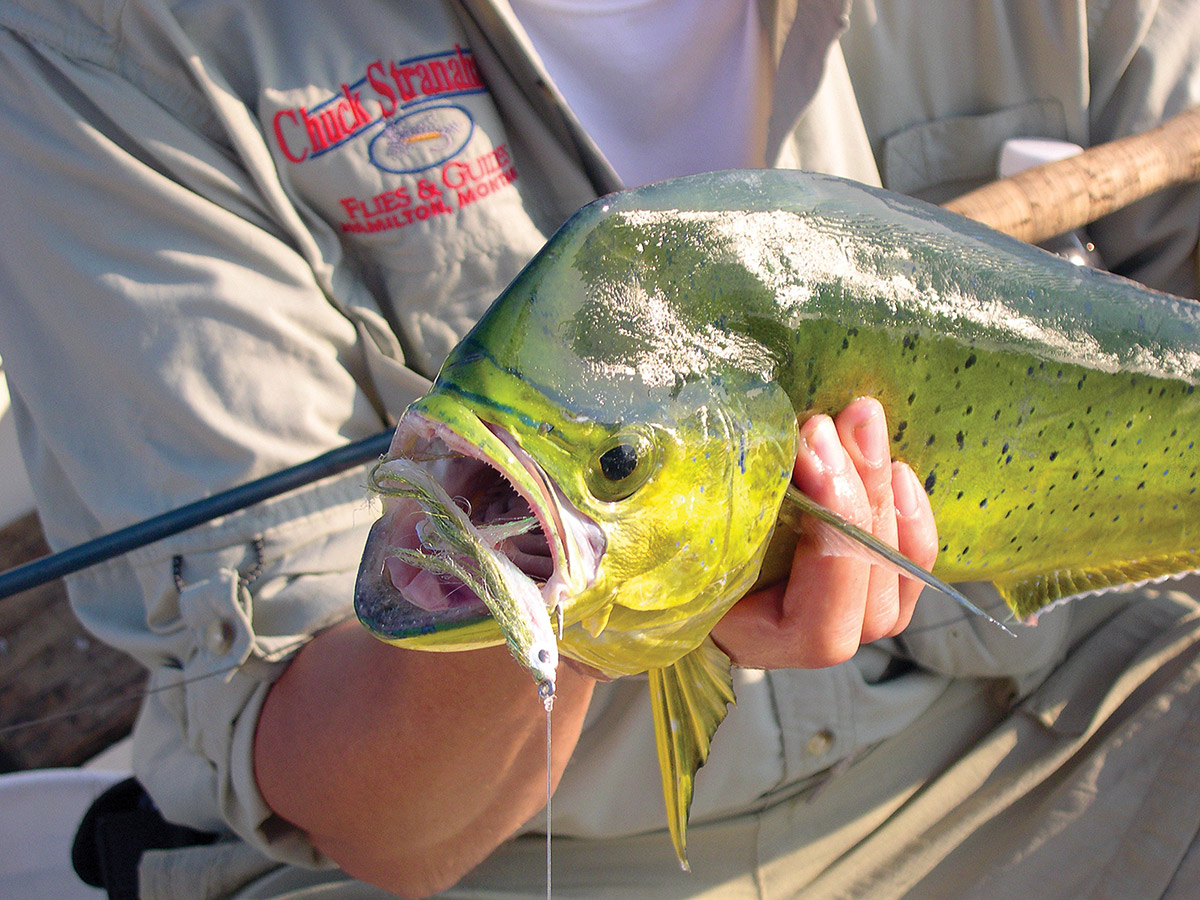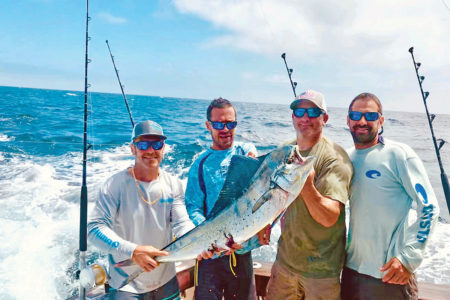
Offshore, midrange, even inshore, there’s no telling where the dorado may turn up this summer.
If you are a saltwater fly fisher that likes to travel to remote destinations to catch mahi-mahi, dolphinfish, or dorado (however you want to name them), then know this – you don’t have to go very far as our Jersey waters are inundated with this species by the middle of summer.
In July and August, a buildup of these dazzling and colorful fish takes place around any lobster pots, buoys, weed lines, sargassum, partially submerged pilings, floating timber, or anything else that serves as a source of structure where a pyramid-like food chain can develop. Mahi use these structures as a source of refuge and find plenty of small baits in these locations that they can feed on.
Dubbed the fastest growing fish in the ocean, mature males are referred to as bulls, and are particularly striking in color draped in a mix of gold, metallic blue and green, with a white and yellow belly. They are also easily distinguished from the females by a prominent forehead that protrudes well above the body proper. Typical size mahi that make up the majority of your catch range in size from small chickens up to about 10 pounds. But there is always a good chance that a bull in excess of 15 pounds can be caught too.

When any mahi that is hooked on the fly hits the teen-pound range it is a nice trophy for my clients. This is true because the opportunities to catch such a fish don’t present themselves to fly fishers on a regular basis. The fight is exhilarating and one that you won’t forget quickly. Bigger mahi make lightning fast runs with screaming drags and then just as quickly become airborne leaving you mesmerized. These leaps and jumps repeat themselves as the mahi tries ceaselessly to spit the hook. The name mahi-mahi means “strong-strong” in Hawaiian and this is no doubt for the great fighting ability of these fish.
A Stealth Approach
In my guiding area east of the Manasquan Inlet our central targets are lobster pots. From 15 to 20 miles out there are strings of pots that stretch for miles along the west side of what is known as the Mud Hole. When approaching a pot I am always hoping that a big mahi may be waiting so I employ a stealth approach. I cut my engines approximately 50 yards away from the pot and just sit in the water as I observe which way the wind and currents are going to drift my boat. When I can get a feel for the drift I then bump my engine into gear and reposition my boat on a line that intercepts the pot bringing my client a cast away from its center. I also look to locate a line of three or four pots that my drift will take me across before I have to crank up the engine and reposition myself.
To see if mahi are present and to put them in a feeding frenzy I bring along live peanut bunker that I net in my marina right before I leave the dock. If I can’t get the live baits then I have a 5-gallon bucket full of sardine chunks or fresh spearing that I am ready to toss at the pot. Since mahi are aggressive feeders many times the first drift past a target produces a strike; that’s why the stealth approach is recommended. With a good pair of polarized sunglasses one can easily spot the mahi attacking the tossed live baits or chunks and following your fly. Many times a feeding frenzy develops right in front of you as your baits are swallowed up as soon as they hit the water. This scenario is one of the ultimate experiences for the fly fisher as the anticipation of a strike is imminent with each cast.
While this is the scenario that dreams are made of sometimes a hungry mahi will turn on the fly, follow it, and then turn away. Therefore I always like to have several fly rods set up with different flies in case the mahi do not strike out at my first offering. In frenzy conditions like this there is no time to try to figure out why your first fly choice is not getting bit. Just grab another rod and try again. Also if a fly gets bit off you don’t have to waste any time tying on a new one.
It’s a big ocean out there with plenty of opportunities to find mahi that are in the mood for feeding so moving around from location to location can be another key to your success. In the heart of the mahi season we expect to catch fish as we know they are present in our waters. For this reason I do not spend too much time on any one piece of structure.

Getting Geared Up
I have found that brightly colored and flashy flies work best to draw strikes. Colors such as bright orange, yellow, florescent green, pink, white, or a mix blend of these colors will work well. I match my fly size to the profile of the chummed bait that I am using. If I am tossing peanuts that have a wide profile then I fish Geno’s Baby Angel or wide bodied deceivers. If the bait’s profile is more slender in appearance, such as when tossing spearing, then Skok’s mushmouths or Popovics’ jiggies, surf candies, or simpleclones are my choice. If I am tossing chunks then I like to use Furimsky’s chunk flies.
I normally fish these flies on a 9-foot, 9- to 10-weight St Croix Legend Elite fast action rod. My hope is that a big bull in the teen size range is just waiting to accommodate my clients. But if the mahi of the day are only small chickens then I break out the 7- to 8-weight rods for some real fun. The reels are Makos or Tibor Riptides spooled with Rio’s Outbound sinking or clear intermediate lines. Both lines will work. I use the sinking lines if the mahi are hanging deep around a buoy or pot, and we are trying to bring them up. But as the mahi become visible near the surface the clear intermediate line works just as well.
Leader lengths are an important consideration in the clear waters of the midshore grounds. On sinking lines many times I tie a straight 7-foot length of fluorocarbon directly to my fly from my fly line. This is longer than I would normally use if I were targeting striped bass along the inshore waters but I am looking for every advantage that I can get to negate the keen eyesight of the mahi.
I usually start with 20-pound test but if I am not drawing strikes when mahi are boiling around the boat I drop this down to 15- or even 12-pound test to elicit a strike. On intermediate fly lines I use a 9- to 10-foot section of fluorocarbon leader.
Not only are mahi one of the most exhilarating pelagics to catch on the fly they also make for fine table fare as their meat is mild-tasting, sweet-flavored, with a firm texture. They can be broiled, poached, baked, sautéed, grilled, or pan-fried.

| LEAVE ‘EM SWIM |
|---|
|
When a small chicken mahi is hooked many times leaving it in the water next to the boat draws other mahi to it. Therefore don’t be afraid to cast out a live bait or chunk on light spinning tackle to hook a mahi so you can leave it in the water and draw other mahi within fly casting range. Capt. Jim Freda |


